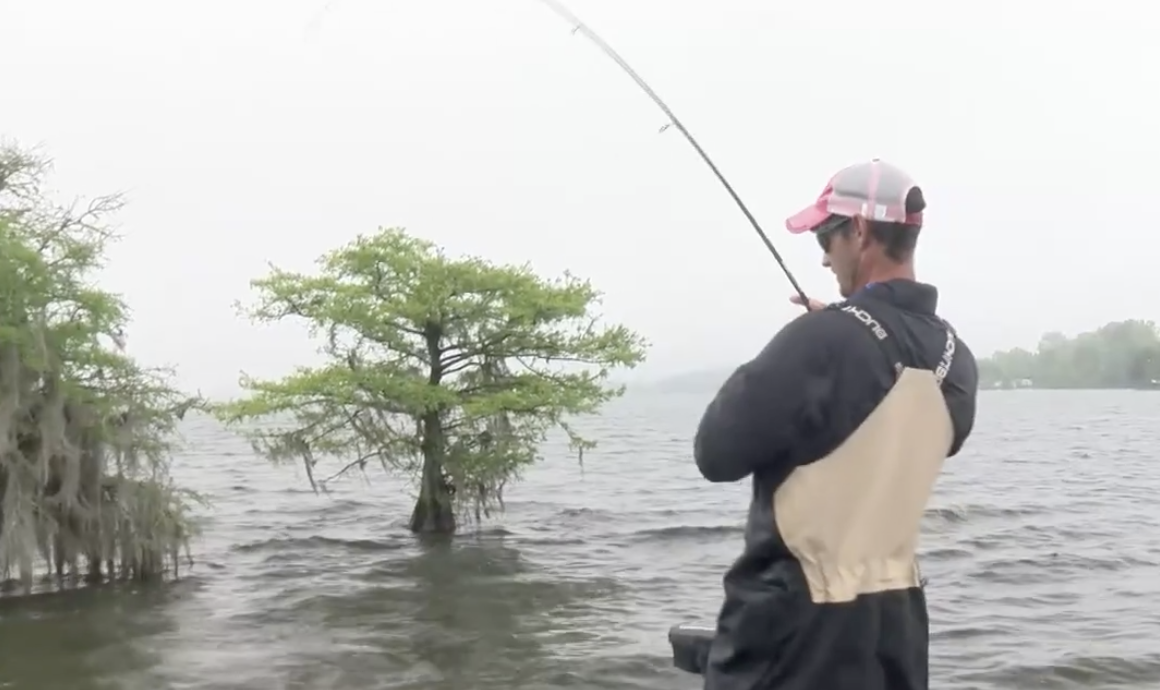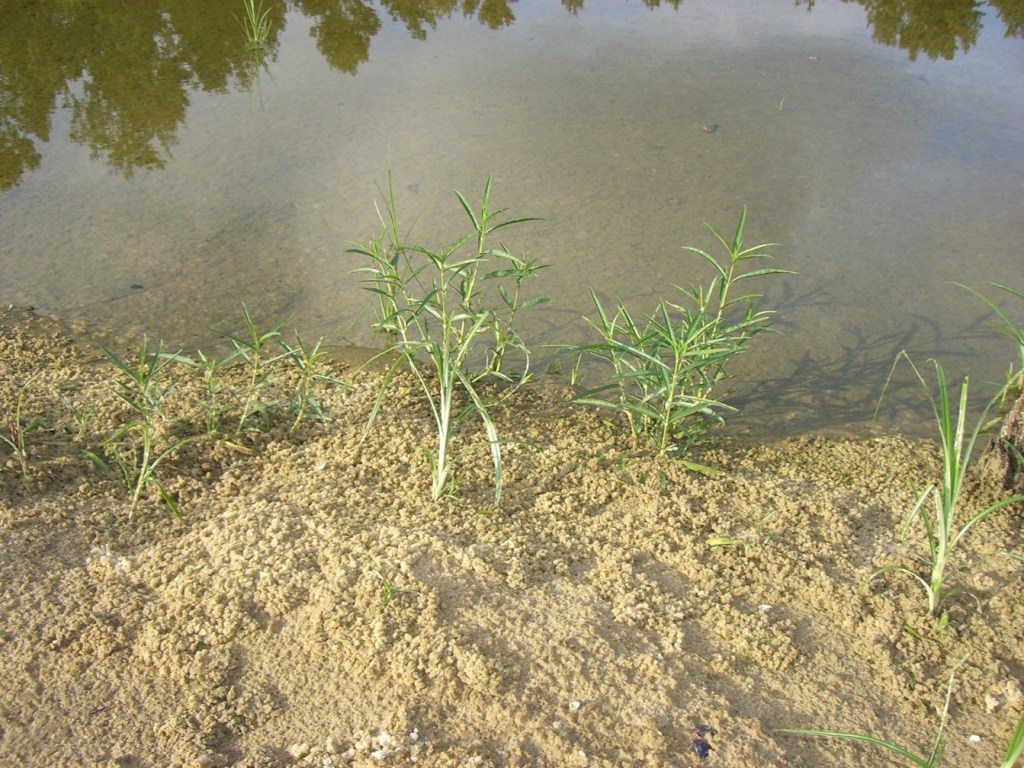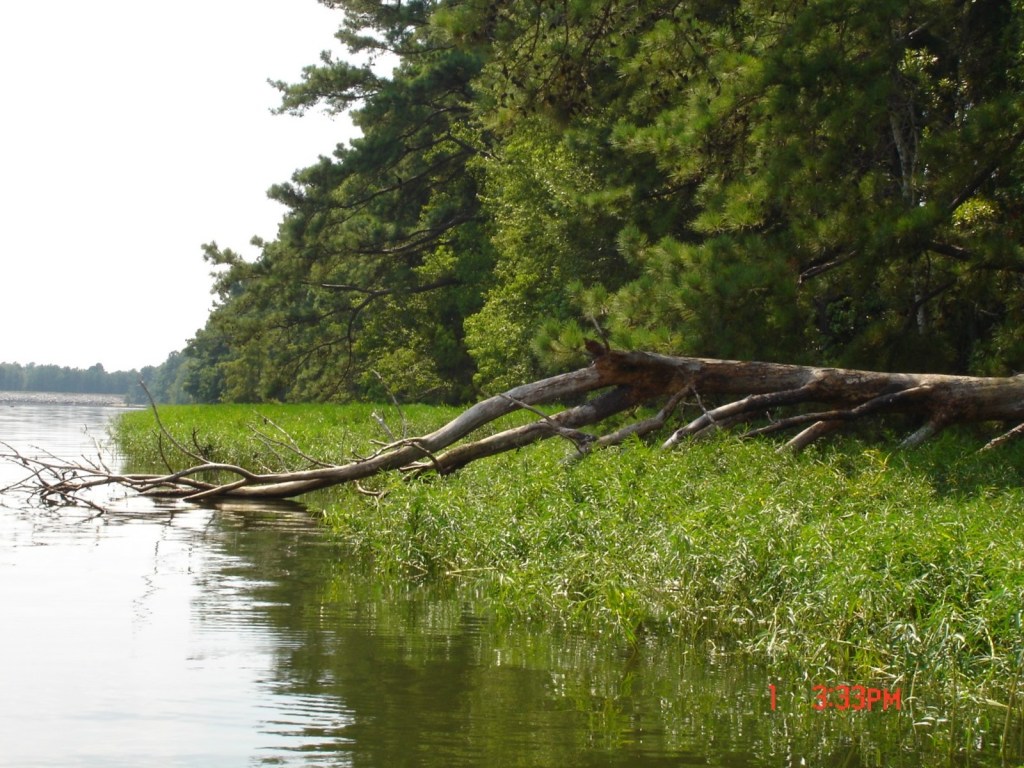
In the early goings of Day 1, Brandon Cobb made an observation with immediate and large-scale implications. Noting that some of his better trees were the ones skirted with eelgrass, the South Carolina pro touched on a key Santee Cooper truth:
Tournament waters hold a lot more eel grass than we saw during last year’s Elite event.
With this native plant checking all the boxes for water filtration, shoreline protection, and bass habitat, Levi Kaczka of the South Carolina Department of Natural Resources attributes the expansion to a combination of natural factors and the agency’s habitat enhancement efforts.
“Water levels have been pretty consistent and we had an early warm up so the growing season started early,” said Kaczka, an SCDNR Regional Coordinator, who oversees Santee Cooper Lakes. “Also, our Habitat Enhancement and Management project includes shoreline native vegetation planting.”
Kaczka said the SCDNR has considered planting maidencane, an emergent plant that has done well in other state reservoirs, but current Santee Cooper efforts are focused on water willow and eelgrass, both naturally occurring species in lakes Marion and Moultrie.

When the Time Is Right
The agency conducts its planting efforts in early- to mid-summer, as much for human comfort as plant survival. For one thing, agency staff do much of their work while standing in the water, so the warmer the better.
“We want to do this in the growing season because we’re harvesting water willow from areas around the lake where it grows in abundance and transplanting it to areas where it’s not growing as well,” Kaczka said. “With the growing season in full swing, it increases our chances of harvesting a healthy plant. (More on the eelgrass in a moment.)
“Also, harvesting a plant and trying to get it to establish somewhere is going to represent stress on the plant, so you’re going to have a higher success rate doing that in the middle of the growing season. We want the plants to establish themselves as quickly as possible and with warmer temperatures, that’s more likely to occur.”
Collection & Relocation
Starting with water willow, SCDNR staff cruise the lake to identify areas of abundance. Working in 2-4 feet of water, they’ll pull up healthy plants, lay them in large Rubbermaid bins, and cover them with wet burlap sacks to minimize harvesting stress.
“We try to harvest the water willow from the substrate,” Kaczka said. “If you were to pull it from the emergent part of the plant or the middle of the water column, you wouldn’t have much success by way of establishment.”
That’s due to the plant’s design. As Kaczka explained, water willow sits on rhizomes (aka “runners”), which extend parallel to the bottom. From these runners, the plant sinks a series of anchoring roots.
“We try to keep the plant as intact as possible,” Kaczka said.
Moving the harvested water willow to a pre-selected area of a mostly barren shoreline, SCDNR staff will position the transplants from the shoreline out to about a foot. Gardening staples secure the rhizomes long enough to allow time for rooting.
“Not only are we targeting areas that don’t have any vegetation, but we’re trying to find a balance to where the local area will benefit from increased vegetation,” Kaczka said. “But you have to keep in mind that there’s a reason why there’s no vegetation there. More often than not, the reason is erosion due to wind a wave action.
“So if you go to a shoreline that’s completely exposed, it would be great to have some vegetation there, but if we try to transplant it there, our efforts are going to be wasted. So we try to find areas that are protected enough for the plants to establish, but open enough that the area is actually going to benefit from the vegetation if it does establish.”
The Eel Deal: Planted eel grass actually originates in Lake Greenwood (two hours northwest of Marion), where the South Carolina Public Service Authority (aka Santee Cooper Electric) has used similar collection methods to acquire plants and transport them to Santee Cooper.
In 2019, the SCDNR fast-tracked Santee Cooper eel grass establishment by placing harvested plants in biodegradable fertilizer cups and planting them in 8-foot by 8-foot plots with exclusion fencing to keep boats off the new transplants. This project includes eight planting sites — four on Marion, four on Moultrie.
“To a lot of people, an 8×8 area on (a system) as big as Santee Cooper sounds small, like ‘What difference can that make?’” Kaczka said. “But a small bit of established vegetation can really take off and spread throughout the lakes.
“The mindset was, rather than take all of this (transplanted eelgrass) and spread one or two of these pint-sized pots throughout the entire lake system, let’s hit a smaller number of areas where we can really concentrate that vegetation and really work to protect that transplanted vegetation and give it the maximum likelihood of establishment.”
Essentially, the agency opted for a course that allowed the greatest control over the vital early stages.
“We felt confident that, if we can get (transplanted eelgrass) to establish even in this small 8X8 area, then nature will do its thing from there and the eelgrass will spread out,” Kaczka said. “It was and is the better approach to doing vegetation transplanting; to focus more on a small area at a time and increase the likelihood of establishment in that localized area and then allow it to spread from there.”
Why It Matters
Even though water willow and eelgrass have been native to Santee Cooper for much of its life, Kaczka points out the reality upon which vegetation planting efforts are premised.
“We have a great fishery, but at the end of the day, it’s not a natural system — it’s manmade,” he said. “On any manmade system, you often hear people say ‘The fishing isn’t what it used to be’ — and they’re not incorrect. But before the lakes were created, aside from what was a very small fraction of (the lakes’ combined 170,000 acres) where the Santee and Cooper rivers flowed through, that was all dry land.
“Then you inundate that land and, in the years that followed, you see an absolute (explosion) in fisheries productivity as the inundation releases all the nutrients from that land. From a bottom-up approach, the food web just booms and naturally, the native fisheries benefit from that. Not only do you get a lot of fish, you get a lot of big fish.”
Santee Cooper has pumped out plenty of both, but like a new car or a fresh piece of bubblegum, lusters and flavors fade. Time levies the ultimate taxation, but the SCDNR is trying to stay ahead of Santee Cooper’s aging process with targeted habitat enhancement efforts.

“In all manmade reservoirs, you have natural degradation — erosion from the shoreline, water management — and after decades of inundation, you just don’t have the same amount of habitat,” Kaczka said. “Think of it like a farm. It’s not uncommon for farmers to work a field for a certain number of years and move to another field to allow nutrients to regenerate in the (previous) field while it lays fallow.
“We don’t have the ability to do that with reservoirs. Once they’re inundated, aside from drawdowns, the vast majority of that land remains inundated. You don’t really have the opportunity to let that land lay fallow and regain nutrients.”
As Kaczka explained, the initial boom of a new reservoir’s nutrient loading and productivity naturally declines, as does the native habitat. While pre-reservoir logging and clear-cutting removed the majority of trees, wind and waves are the present-day culprits.
“What we’re trying to do is reestablish some native vegetation that we would expect to have been there in and along the rivers, as well as the vegetation that grew in the years following lake construction,” Kaczka said. “It’s a balance, because even though it’s well established from the general public and biologists that vegetation is a good thing for fish and wildlife, these are multi-use lakes.
“It’s not just the anglers that have a say in (lake management); it’s folks that live on the lakes that may not care about fishing, and there are folks that waterski or jet ski on the lake that would rather have a lake with no vegetation. And then there’s the idea of hydropower, where the more vegetation you have, the more problems you have with generating electricity.”
If maximum fishing opportunity solely defined the SCDNR’s objective, managing Santee Cooper would be a much simpler task. But that’s not reality, so the big picture must be considered.
“We have to find that balance for the multi-use aspect, so what we’re trying to do is regain some of that ground that we lost over the years due to natural causes, due to vegetation management and competing interests,” Kaczka said. “But that doesn’t mean we can’t find that balance to where everyone can benefit.”





